Nursing Assignment Report: Pressure Sores Education Tool Proposal
VerifiedAdded on 2023/05/27
|22
|2394
|444
Report
AI Summary
This report focuses on pressure sores, also known as pressure ulcers, which are localized injuries to the skin or underlying tissue caused by pressure, often over bony prominences. It explores the signs, symptoms, and risk factors, including immobility and poor nutrition, along with potential complications like cellulitis and sepsis. The report delves into the pathophysiology, stages of pressure ulcers, and clinical manifestations, including treatments like antibacterial drugs and debridement. The target audience is identified as clinicians, emphasizing the need for education and training. The educational intervention process, including comprehensive wound assessment and documentation, is detailed. The report highlights gaps in education and training and introduces the PUSH tool for monitoring ulcer healing. The overall goal is to improve outcomes through education, prevention strategies, and patient awareness.
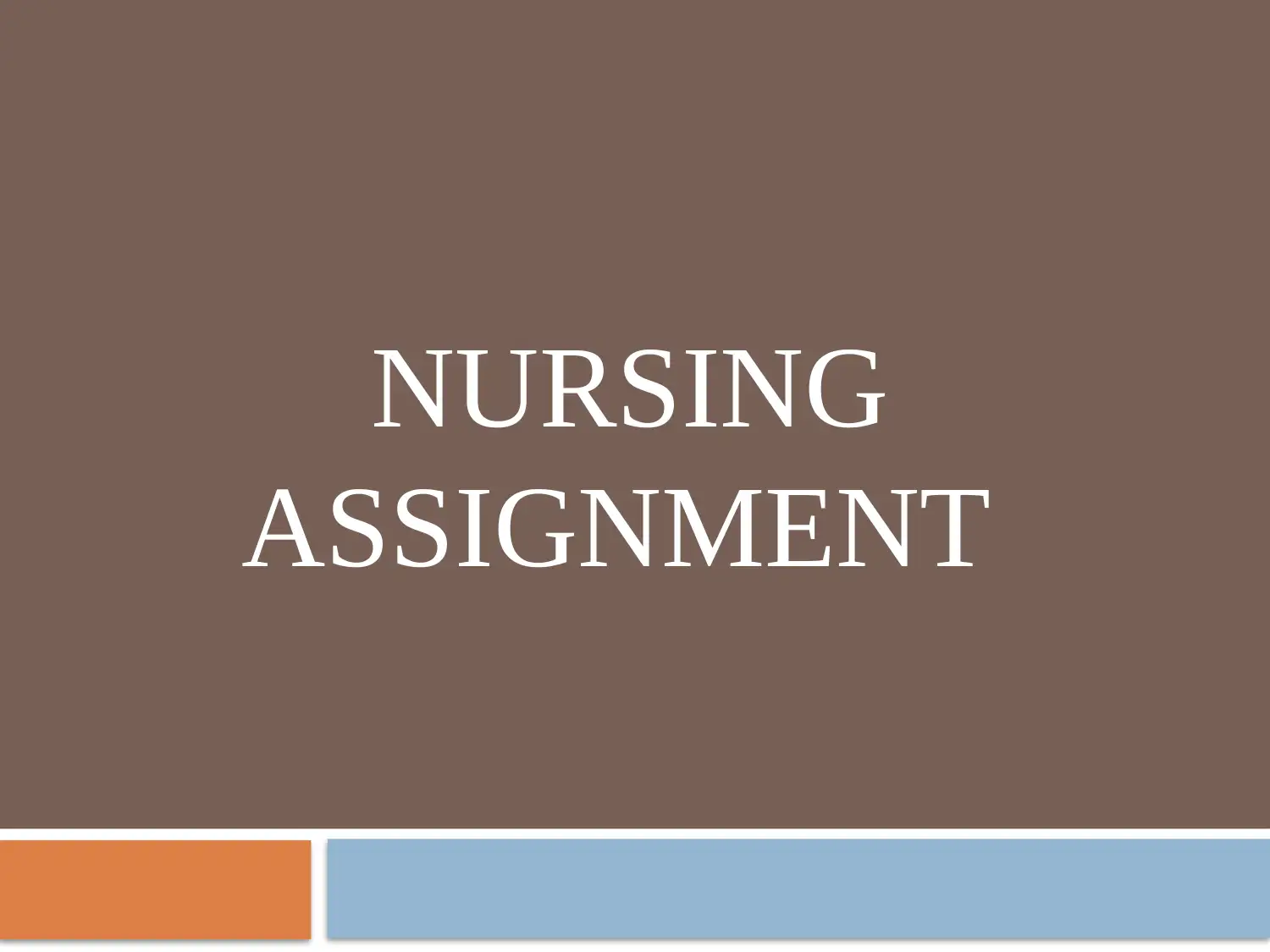
NURSING
ASSIGNMENT
ASSIGNMENT
Secure Best Marks with AI Grader
Need help grading? Try our AI Grader for instant feedback on your assignments.
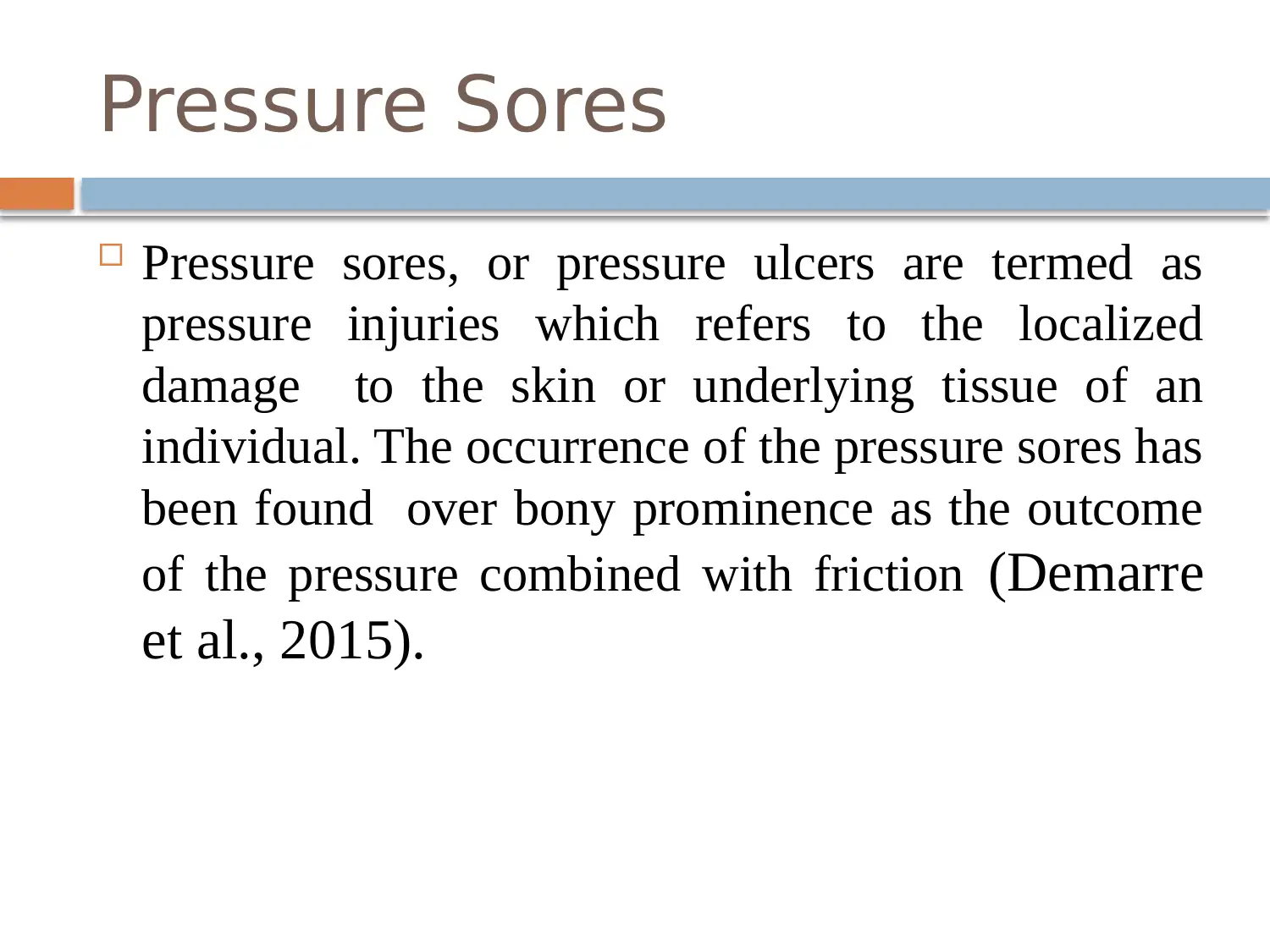
Pressure Sores
Pressure sores, or pressure ulcers are termed as
pressure injuries which refers to the localized
damage to the skin or underlying tissue of an
individual. The occurrence of the pressure sores has
been found over bony prominence as the outcome
of the pressure combined with friction (Demarre
et al., 2015).
Pressure sores, or pressure ulcers are termed as
pressure injuries which refers to the localized
damage to the skin or underlying tissue of an
individual. The occurrence of the pressure sores has
been found over bony prominence as the outcome
of the pressure combined with friction (Demarre
et al., 2015).
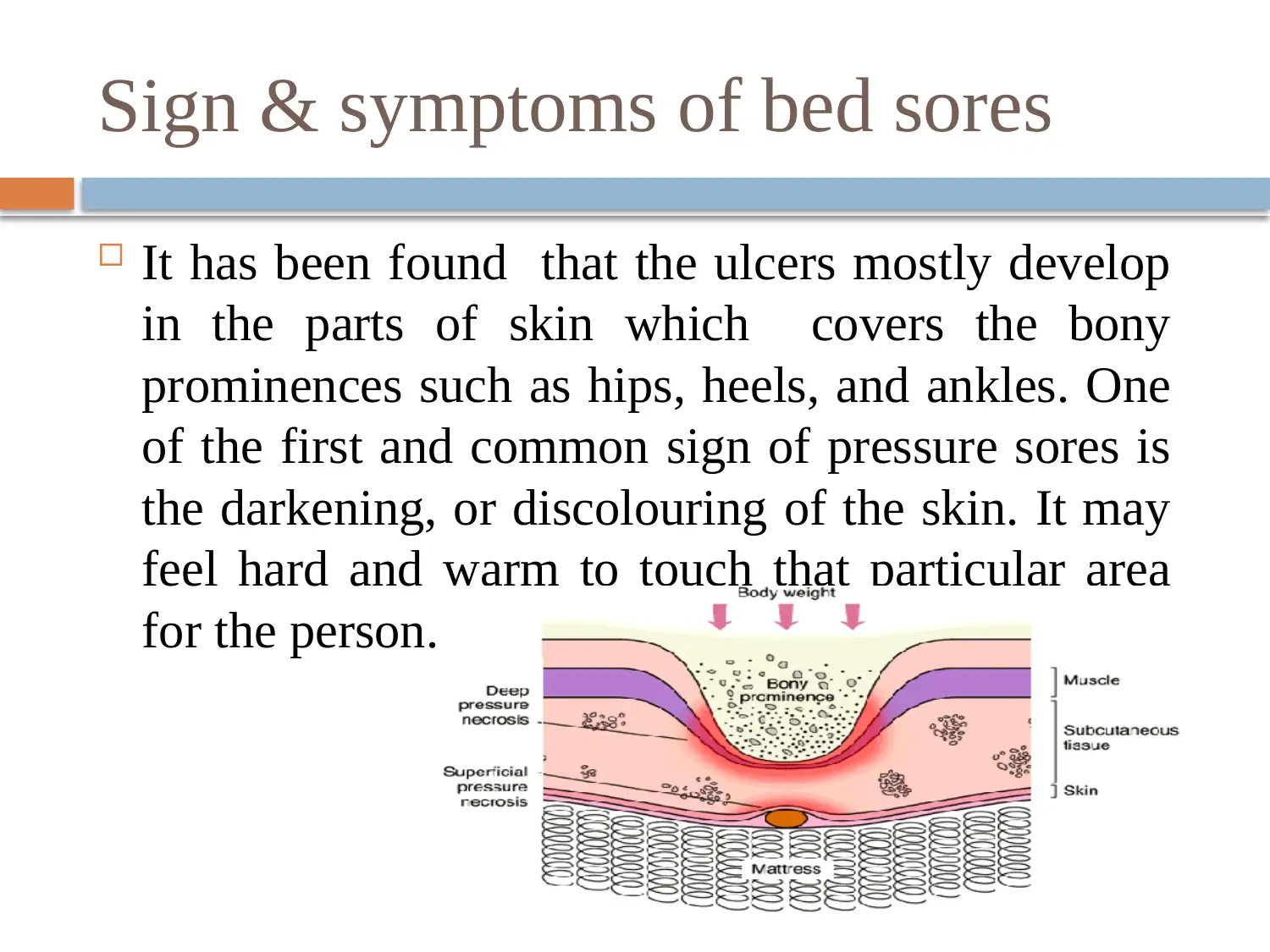
Sign & symptoms of bed sores
It has been found that the ulcers mostly develop
in the parts of skin which covers the bony
prominences such as hips, heels, and ankles. One
of the first and common sign of pressure sores is
the darkening, or discolouring of the skin. It may
feel hard and warm to touch that particular area
for the person.
It has been found that the ulcers mostly develop
in the parts of skin which covers the bony
prominences such as hips, heels, and ankles. One
of the first and common sign of pressure sores is
the darkening, or discolouring of the skin. It may
feel hard and warm to touch that particular area
for the person.
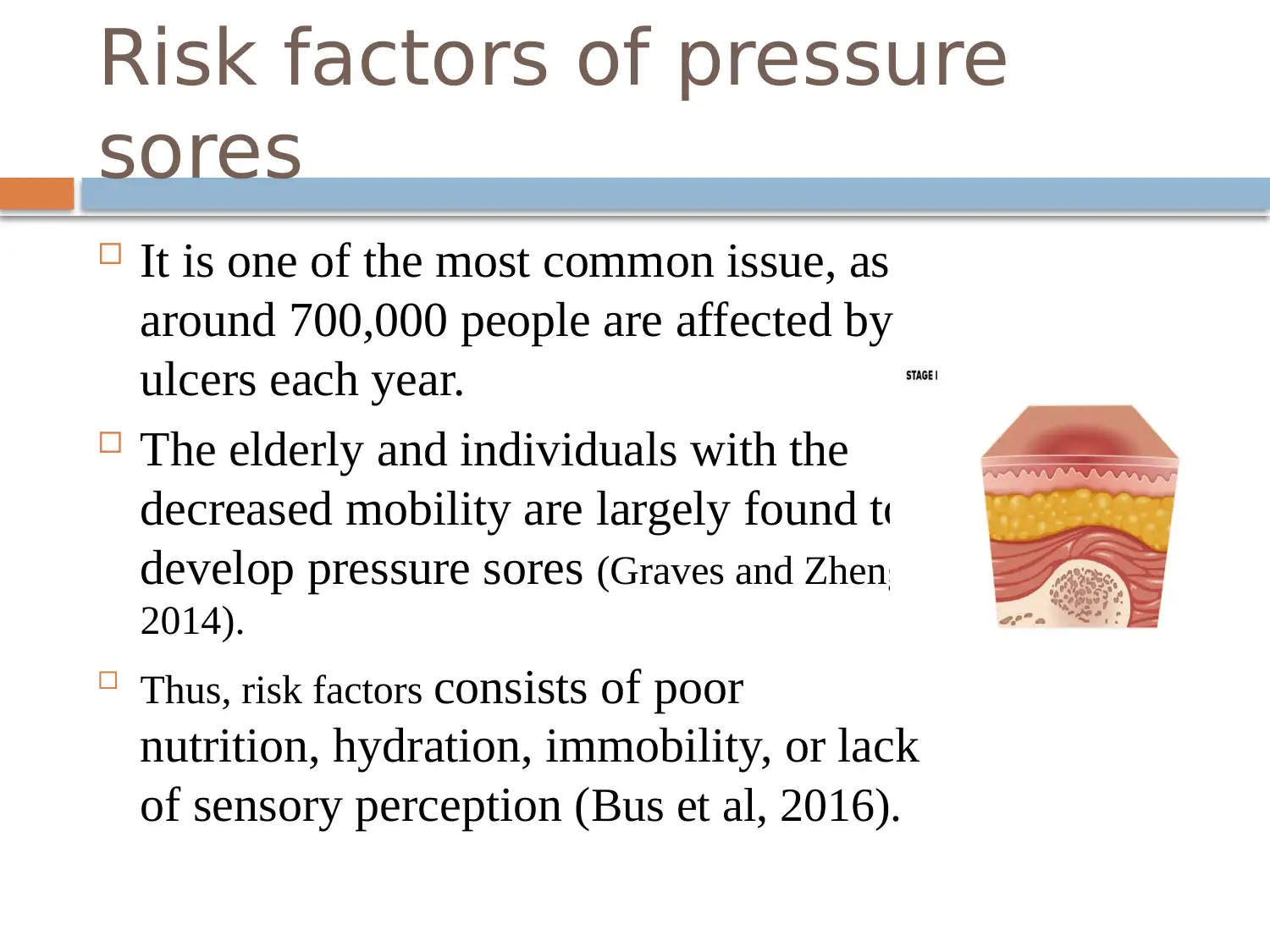
Risk factors of pressure
sores
It is one of the most common issue, as
around 700,000 people are affected by
ulcers each year.
The elderly and individuals with the
decreased mobility are largely found to
develop pressure sores (Graves and Zheng,
2014).
Thus, risk factors consists of poor
nutrition, hydration, immobility, or lack
of sensory perception (Bus et al, 2016).
sores
It is one of the most common issue, as
around 700,000 people are affected by
ulcers each year.
The elderly and individuals with the
decreased mobility are largely found to
develop pressure sores (Graves and Zheng,
2014).
Thus, risk factors consists of poor
nutrition, hydration, immobility, or lack
of sensory perception (Bus et al, 2016).
Secure Best Marks with AI Grader
Need help grading? Try our AI Grader for instant feedback on your assignments.
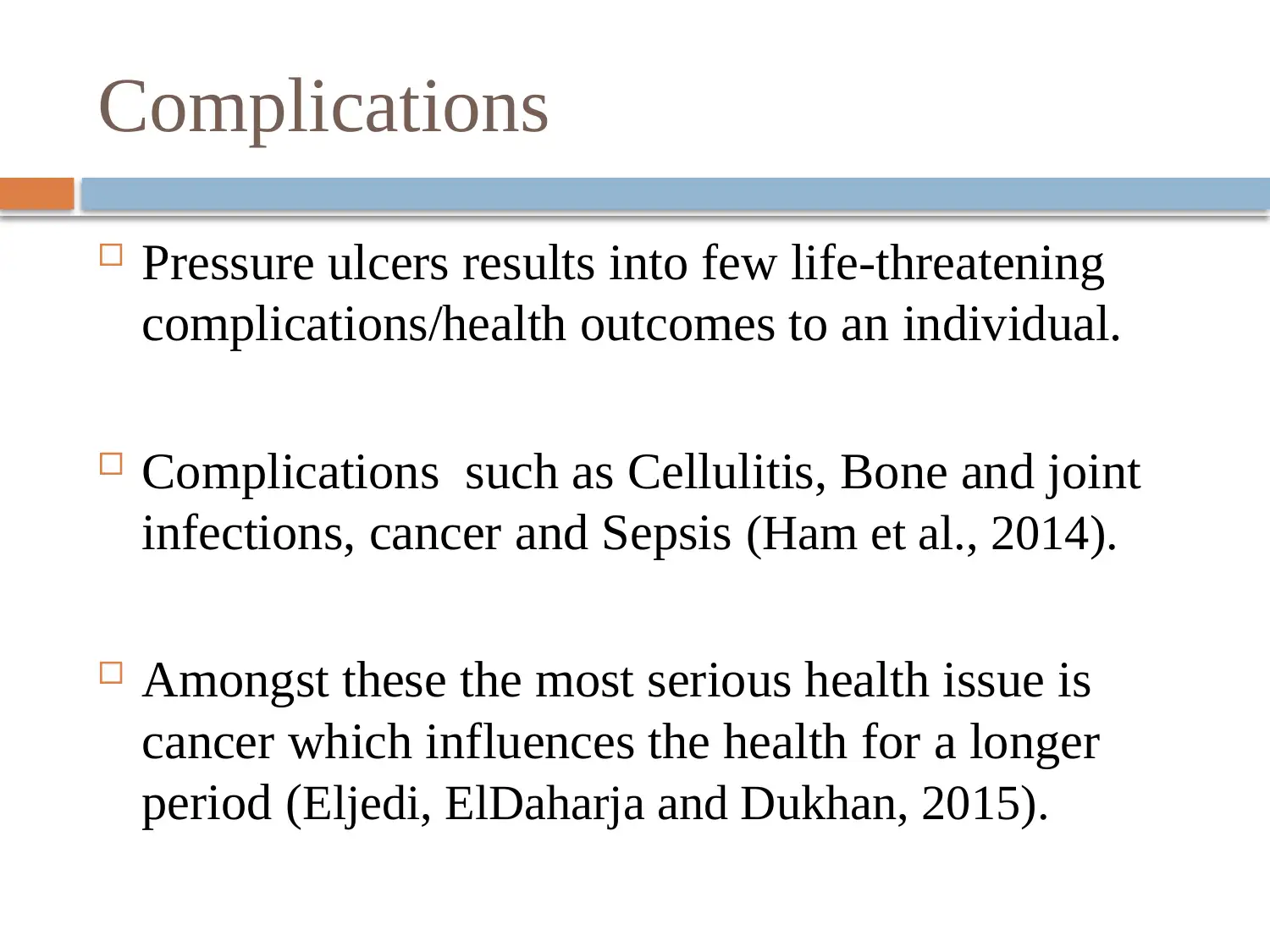
Complications
Pressure ulcers results into few life-threatening
complications/health outcomes to an individual.
Complications such as Cellulitis, Bone and joint
infections, cancer and Sepsis (Ham et al., 2014).
Amongst these the most serious health issue is
cancer which influences the health for a longer
period (Eljedi, ElDaharja and Dukhan, 2015).
Pressure ulcers results into few life-threatening
complications/health outcomes to an individual.
Complications such as Cellulitis, Bone and joint
infections, cancer and Sepsis (Ham et al., 2014).
Amongst these the most serious health issue is
cancer which influences the health for a longer
period (Eljedi, ElDaharja and Dukhan, 2015).

General prevention
To prevent the issue of pressure ulcers,
an individual can work on reducing the
stress on their skin.
It also includes taking care of the skin,
intake of good nutrition, quitting
smoking, or exercising daily.
Acquiring required information or
knowledge will also assist the patient
towards improvement.
To prevent the issue of pressure ulcers,
an individual can work on reducing the
stress on their skin.
It also includes taking care of the skin,
intake of good nutrition, quitting
smoking, or exercising daily.
Acquiring required information or
knowledge will also assist the patient
towards improvement.

Pathophysiology
Pressure ulcers are mostly caused due to inadequate
blood supply and resulting reperfusion injury on re-
entering of blood into the tissue (Di Monaco et al.,
2015).
The sore can be exemplified as the pain or ache
experienced by individuals for long periods of time.
The individuals or target audience in these cases are
the patients/ consumers (Rajaram, Barnard and Bilimoria,
2015).
Pressure ulcers are mostly caused due to inadequate
blood supply and resulting reperfusion injury on re-
entering of blood into the tissue (Di Monaco et al.,
2015).
The sore can be exemplified as the pain or ache
experienced by individuals for long periods of time.
The individuals or target audience in these cases are
the patients/ consumers (Rajaram, Barnard and Bilimoria,
2015).
Paraphrase This Document
Need a fresh take? Get an instant paraphrase of this document with our AI Paraphraser
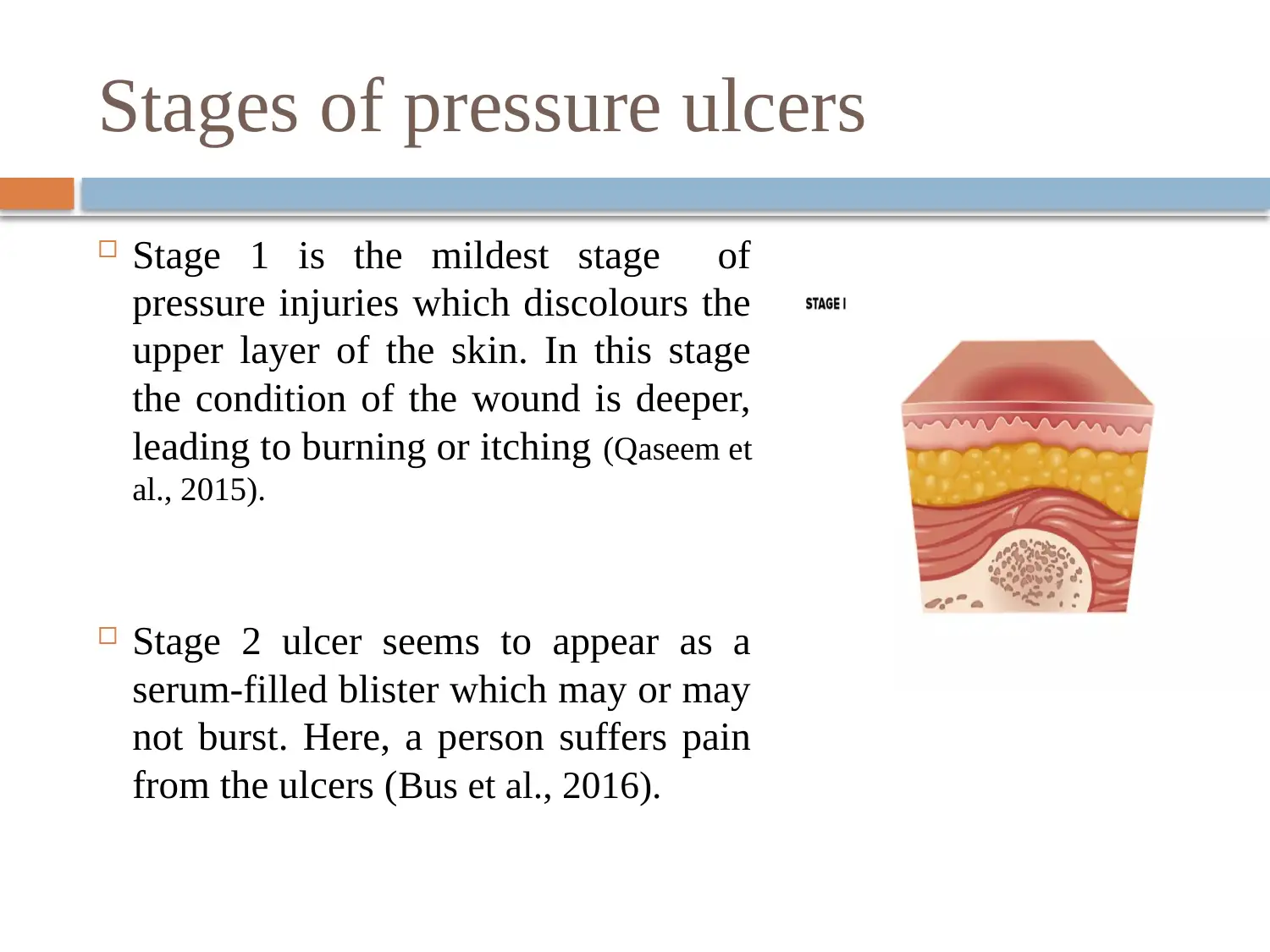
Stages of pressure ulcers
Stage 1 is the mildest stage of
pressure injuries which discolours the
upper layer of the skin. In this stage
the condition of the wound is deeper,
leading to burning or itching (Qaseem et
al., 2015).
Stage 2 ulcer seems to appear as a
serum-filled blister which may or may
not burst. Here, a person suffers pain
from the ulcers (Bus et al., 2016).
Stage 1 is the mildest stage of
pressure injuries which discolours the
upper layer of the skin. In this stage
the condition of the wound is deeper,
leading to burning or itching (Qaseem et
al., 2015).
Stage 2 ulcer seems to appear as a
serum-filled blister which may or may
not burst. Here, a person suffers pain
from the ulcers (Bus et al., 2016).
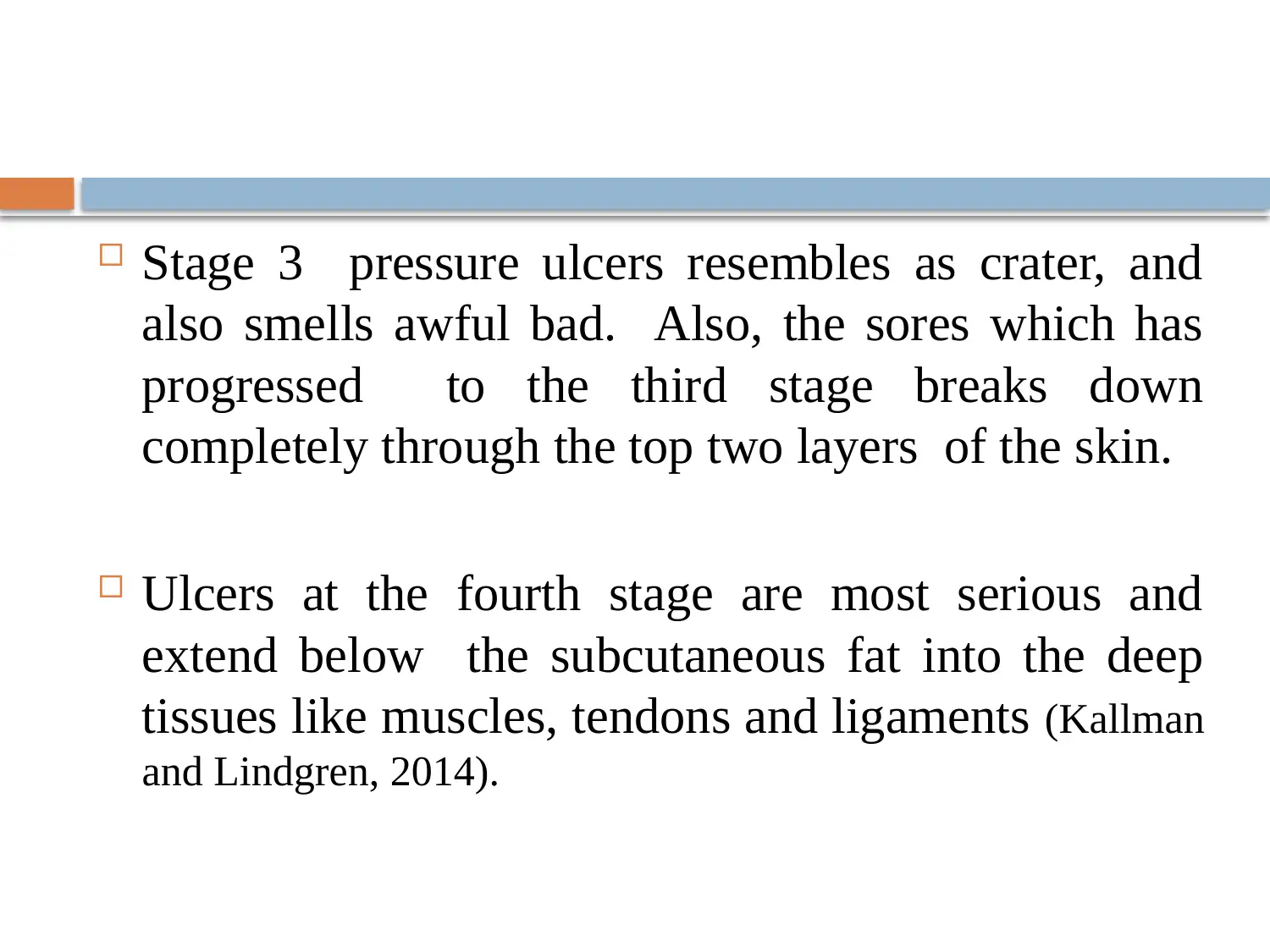
Stage 3 pressure ulcers resembles as crater, and
also smells awful bad. Also, the sores which has
progressed to the third stage breaks down
completely through the top two layers of the skin.
Ulcers at the fourth stage are most serious and
extend below the subcutaneous fat into the deep
tissues like muscles, tendons and ligaments (Kallman
and Lindgren, 2014).
also smells awful bad. Also, the sores which has
progressed to the third stage breaks down
completely through the top two layers of the skin.
Ulcers at the fourth stage are most serious and
extend below the subcutaneous fat into the deep
tissues like muscles, tendons and ligaments (Kallman
and Lindgren, 2014).
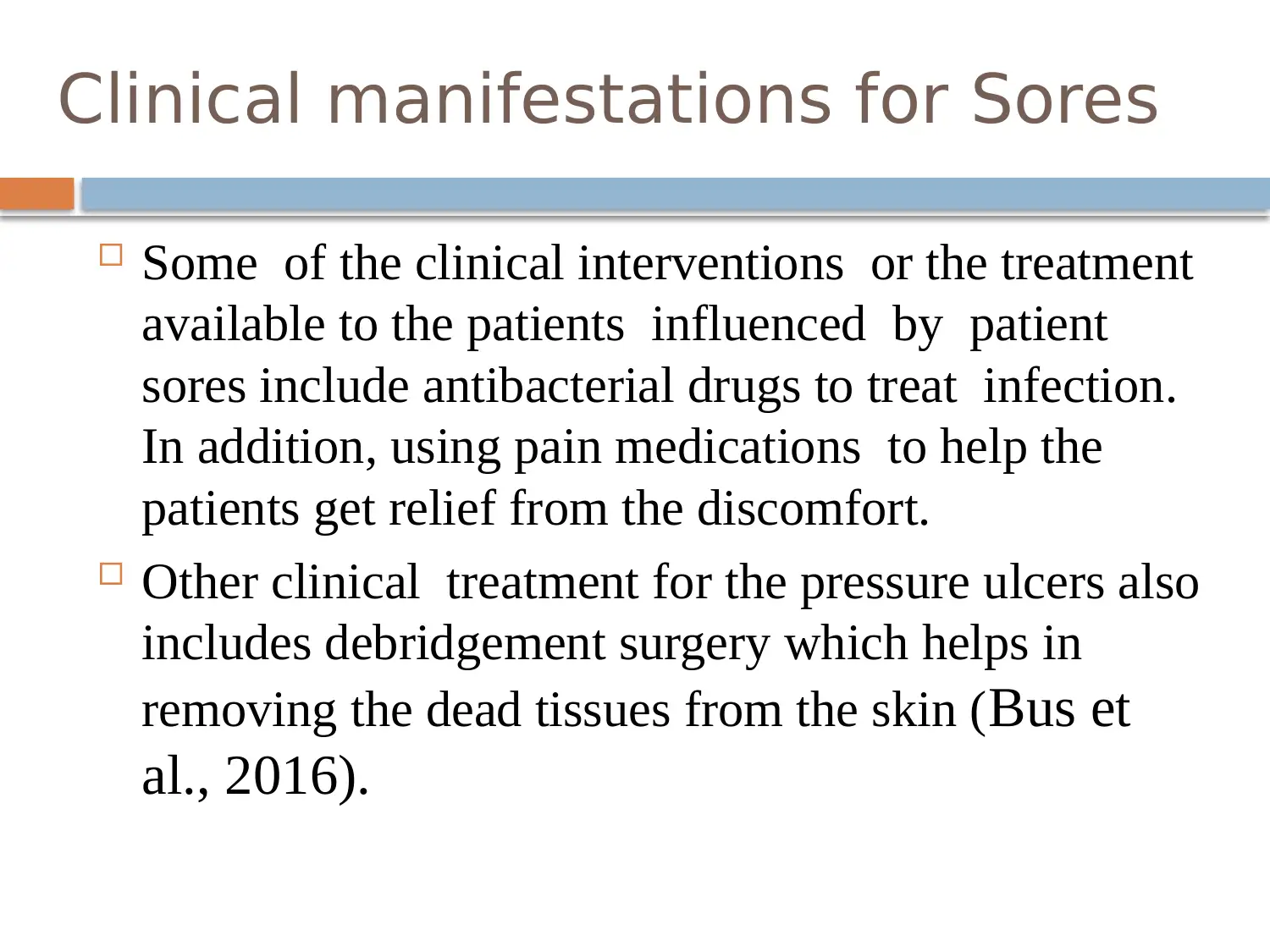
Clinical manifestations for Sores
Some of the clinical interventions or the treatment
available to the patients influenced by patient
sores include antibacterial drugs to treat infection.
In addition, using pain medications to help the
patients get relief from the discomfort.
Other clinical treatment for the pressure ulcers also
includes debridgement surgery which helps in
removing the dead tissues from the skin (Bus et
al., 2016).
Some of the clinical interventions or the treatment
available to the patients influenced by patient
sores include antibacterial drugs to treat infection.
In addition, using pain medications to help the
patients get relief from the discomfort.
Other clinical treatment for the pressure ulcers also
includes debridgement surgery which helps in
removing the dead tissues from the skin (Bus et
al., 2016).
Secure Best Marks with AI Grader
Need help grading? Try our AI Grader for instant feedback on your assignments.
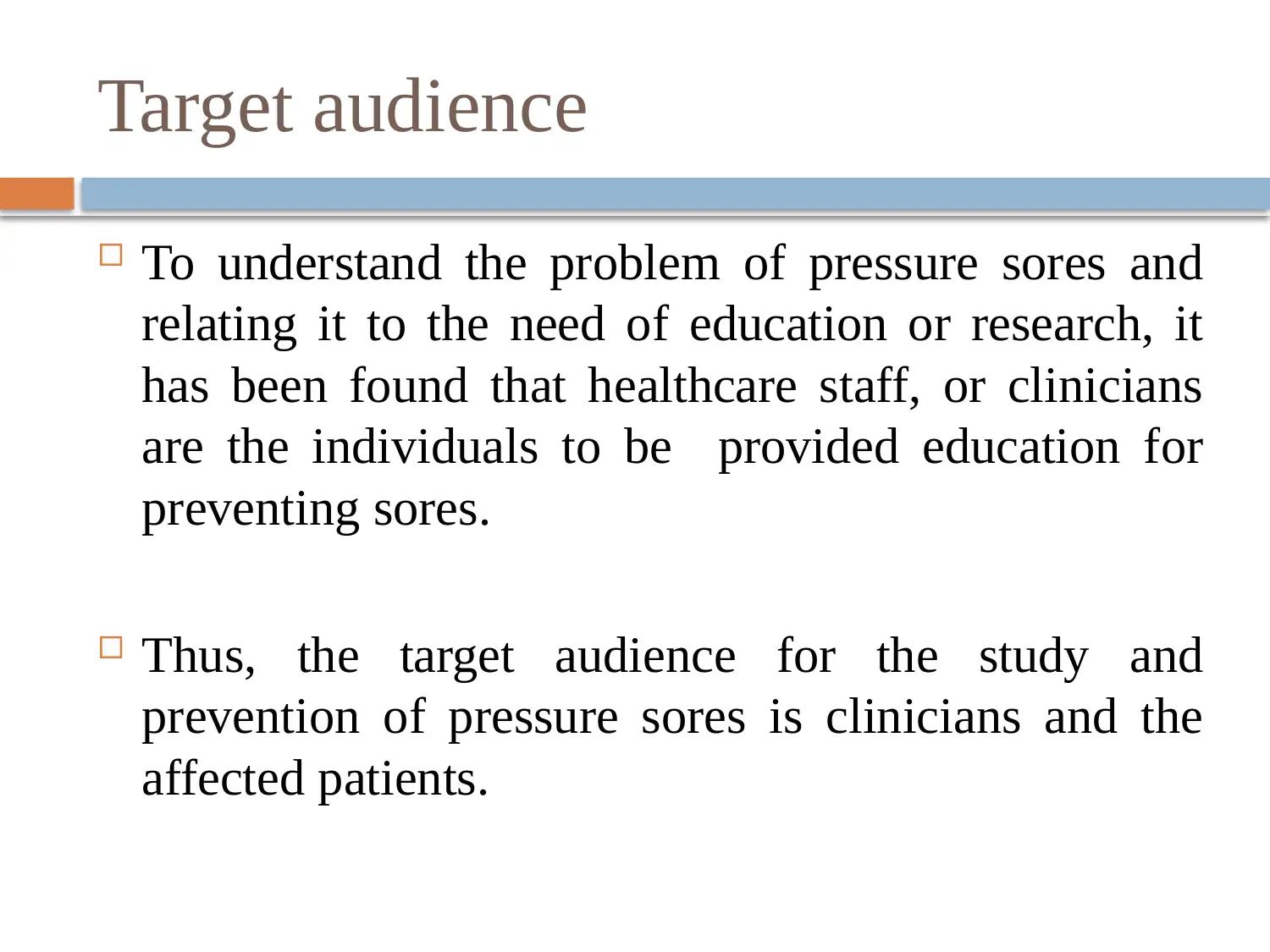
Target audience
To understand the problem of pressure sores and
relating it to the need of education or research, it
has been found that healthcare staff, or clinicians
are the individuals to be provided education for
preventing sores.
Thus, the target audience for the study and
prevention of pressure sores is clinicians and the
affected patients.
To understand the problem of pressure sores and
relating it to the need of education or research, it
has been found that healthcare staff, or clinicians
are the individuals to be provided education for
preventing sores.
Thus, the target audience for the study and
prevention of pressure sores is clinicians and the
affected patients.
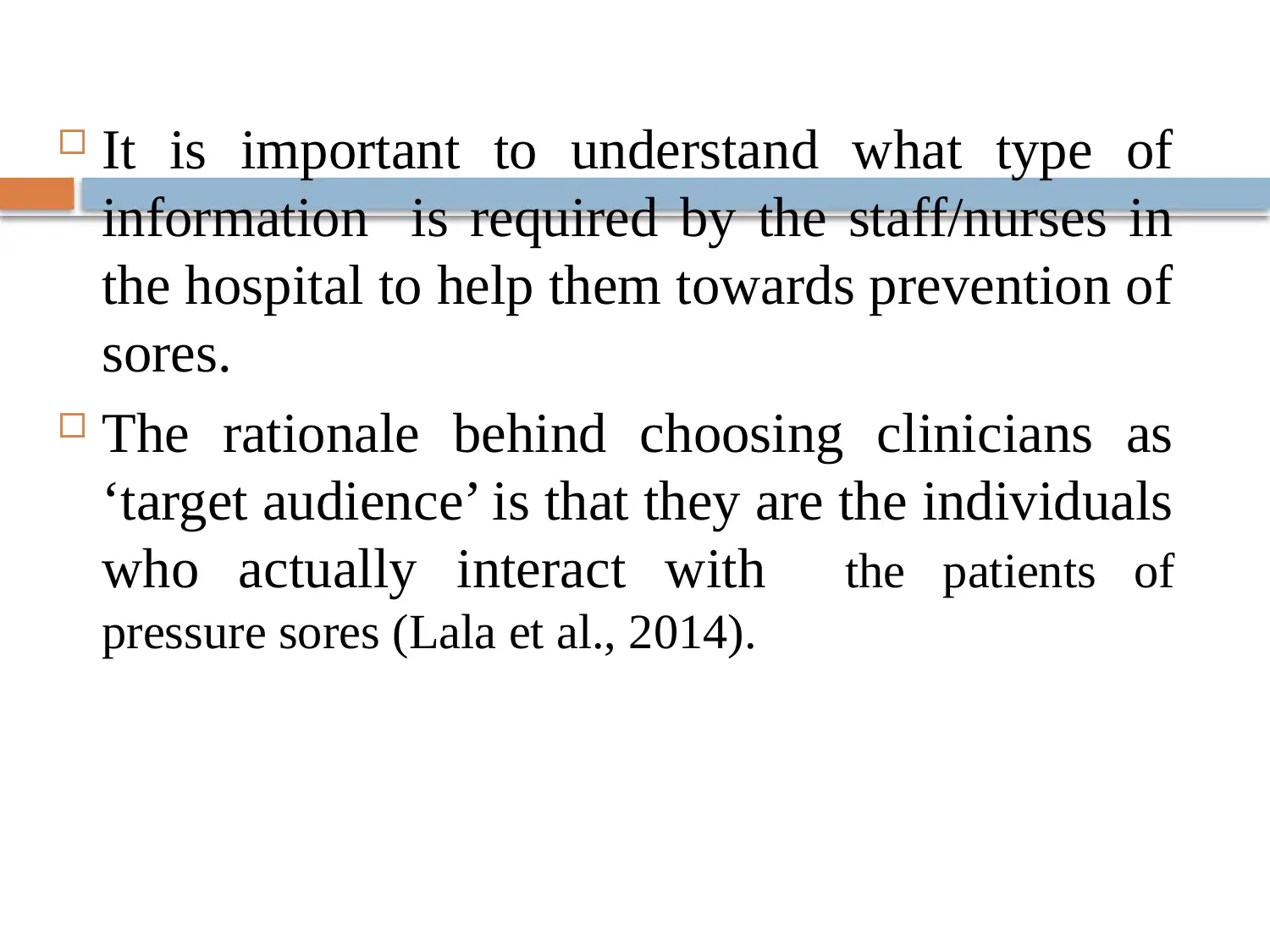
It is important to understand what type of
information is required by the staff/nurses in
the hospital to help them towards prevention of
sores.
The rationale behind choosing clinicians as
‘target audience’ is that they are the individuals
who actually interact with the patients of
pressure sores (Lala et al., 2014).
information is required by the staff/nurses in
the hospital to help them towards prevention of
sores.
The rationale behind choosing clinicians as
‘target audience’ is that they are the individuals
who actually interact with the patients of
pressure sores (Lala et al., 2014).
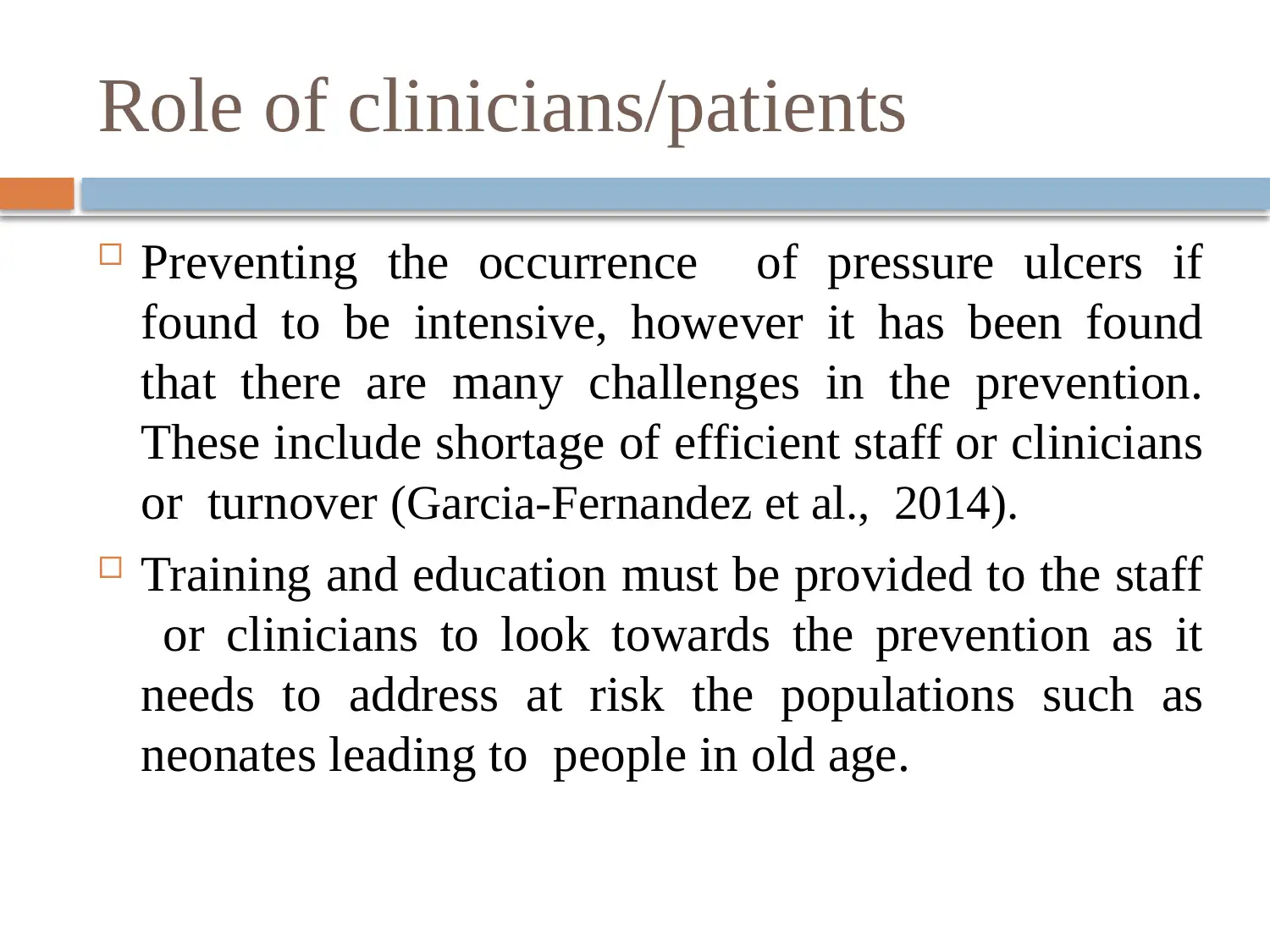
Role of clinicians/patients
Preventing the occurrence of pressure ulcers if
found to be intensive, however it has been found
that there are many challenges in the prevention.
These include shortage of efficient staff or clinicians
or turnover (Garcia-Fernandez et al., 2014).
Training and education must be provided to the staff
or clinicians to look towards the prevention as it
needs to address at risk the populations such as
neonates leading to people in old age.
Preventing the occurrence of pressure ulcers if
found to be intensive, however it has been found
that there are many challenges in the prevention.
These include shortage of efficient staff or clinicians
or turnover (Garcia-Fernandez et al., 2014).
Training and education must be provided to the staff
or clinicians to look towards the prevention as it
needs to address at risk the populations such as
neonates leading to people in old age.
Paraphrase This Document
Need a fresh take? Get an instant paraphrase of this document with our AI Paraphraser
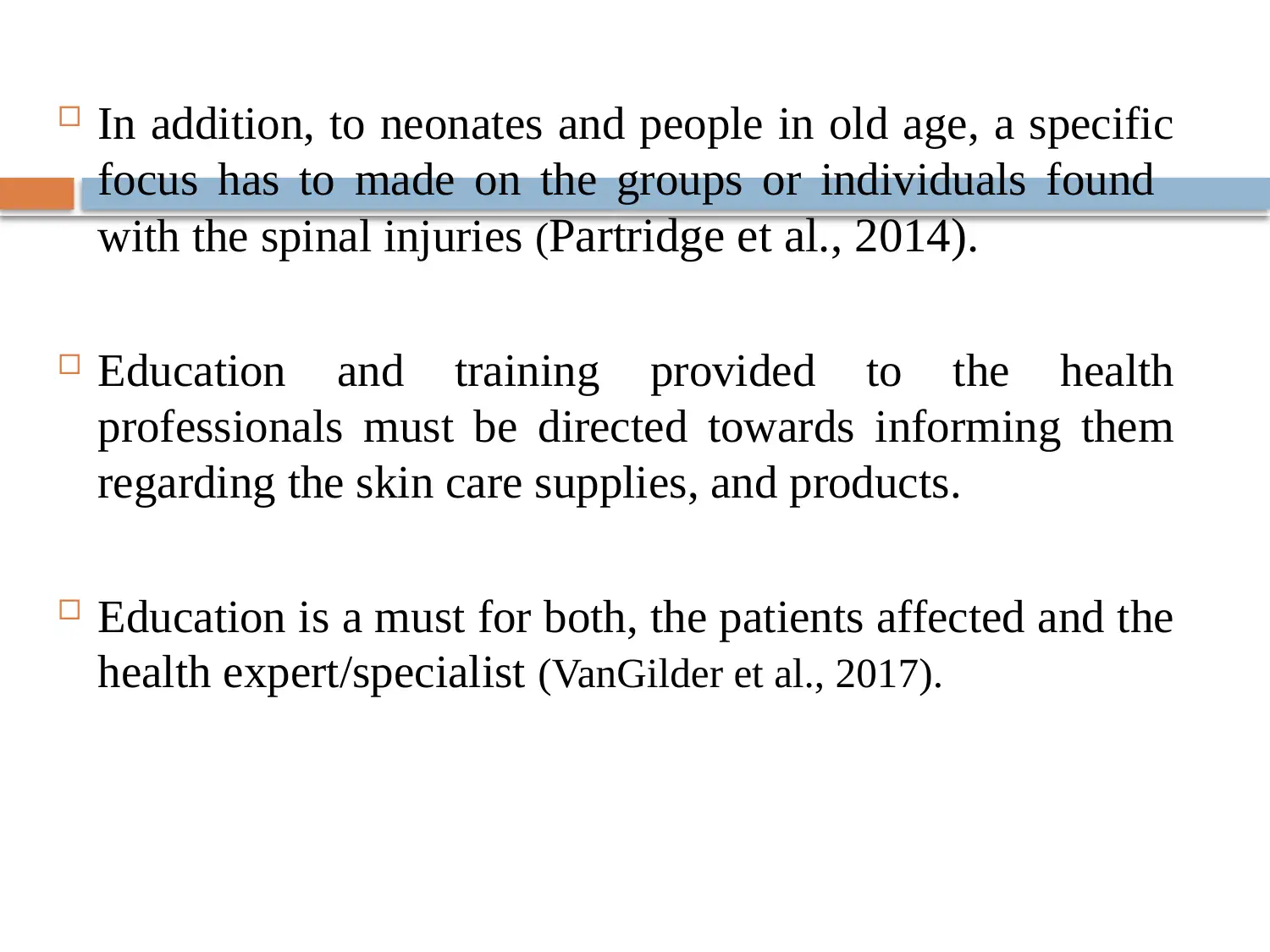
In addition, to neonates and people in old age, a specific
focus has to made on the groups or individuals found
with the spinal injuries (Partridge et al., 2014).
Education and training provided to the health
professionals must be directed towards informing them
regarding the skin care supplies, and products.
Education is a must for both, the patients affected and the
health expert/specialist (VanGilder et al., 2017).
focus has to made on the groups or individuals found
with the spinal injuries (Partridge et al., 2014).
Education and training provided to the health
professionals must be directed towards informing them
regarding the skin care supplies, and products.
Education is a must for both, the patients affected and the
health expert/specialist (VanGilder et al., 2017).
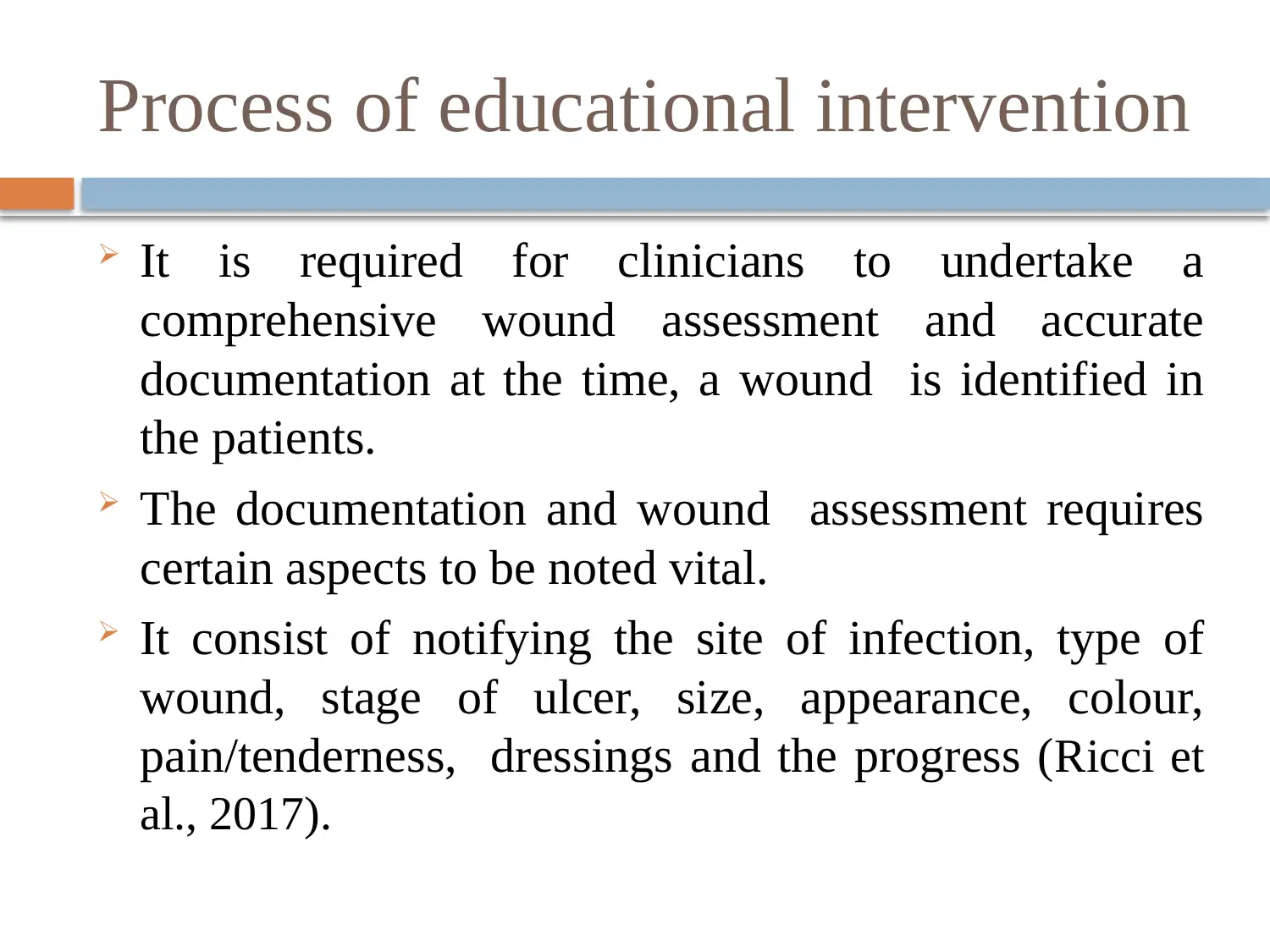
Process of educational intervention
It is required for clinicians to undertake a
comprehensive wound assessment and accurate
documentation at the time, a wound is identified in
the patients.
The documentation and wound assessment requires
certain aspects to be noted vital.
It consist of notifying the site of infection, type of
wound, stage of ulcer, size, appearance, colour,
pain/tenderness, dressings and the progress (Ricci et
al., 2017).
It is required for clinicians to undertake a
comprehensive wound assessment and accurate
documentation at the time, a wound is identified in
the patients.
The documentation and wound assessment requires
certain aspects to be noted vital.
It consist of notifying the site of infection, type of
wound, stage of ulcer, size, appearance, colour,
pain/tenderness, dressings and the progress (Ricci et
al., 2017).
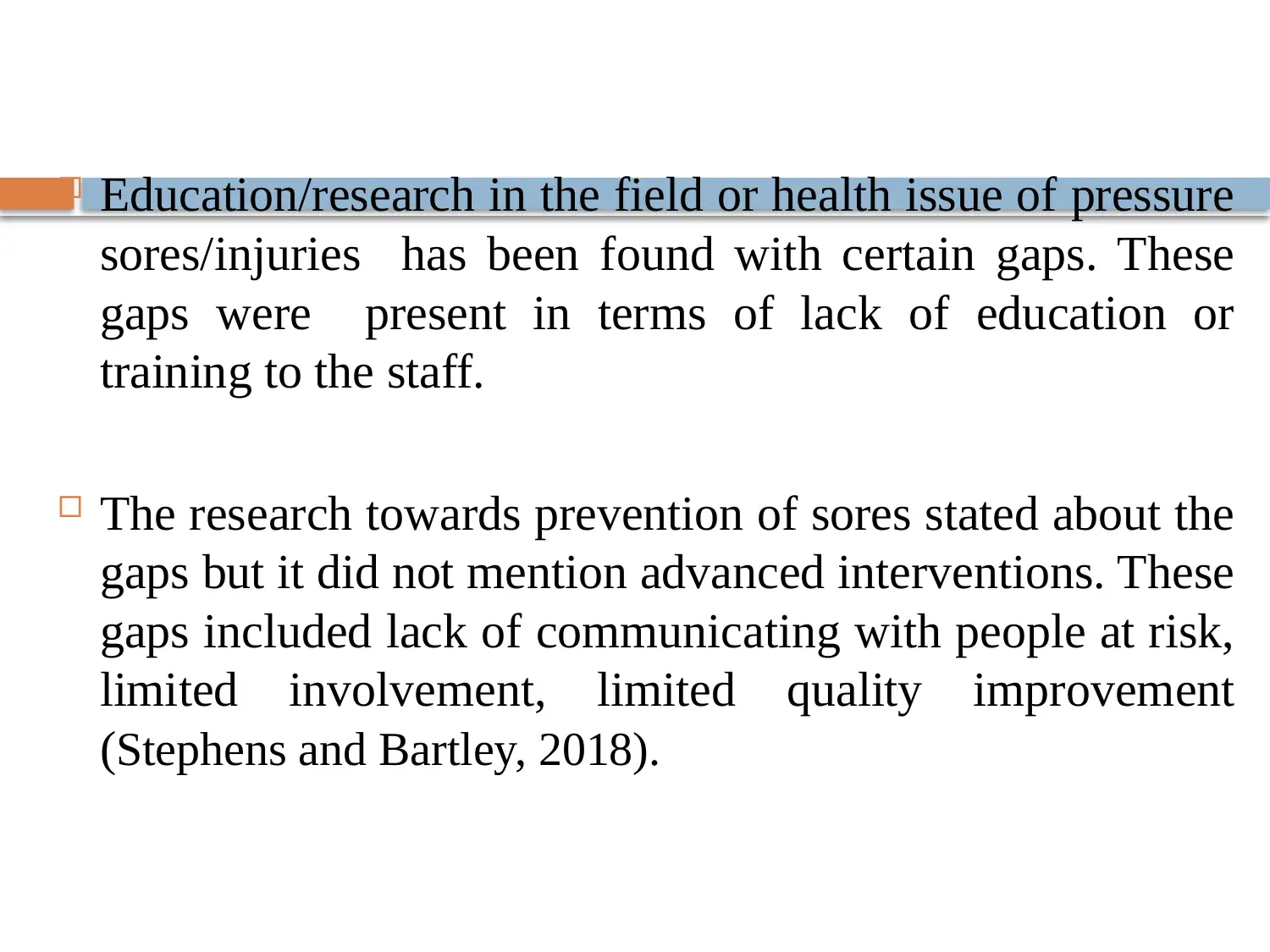
Education/research in the field or health issue of pressure
sores/injuries has been found with certain gaps. These
gaps were present in terms of lack of education or
training to the staff.
The research towards prevention of sores stated about the
gaps but it did not mention advanced interventions. These
gaps included lack of communicating with people at risk,
limited involvement, limited quality improvement
(Stephens and Bartley, 2018).
sores/injuries has been found with certain gaps. These
gaps were present in terms of lack of education or
training to the staff.
The research towards prevention of sores stated about the
gaps but it did not mention advanced interventions. These
gaps included lack of communicating with people at risk,
limited involvement, limited quality improvement
(Stephens and Bartley, 2018).
Secure Best Marks with AI Grader
Need help grading? Try our AI Grader for instant feedback on your assignments.
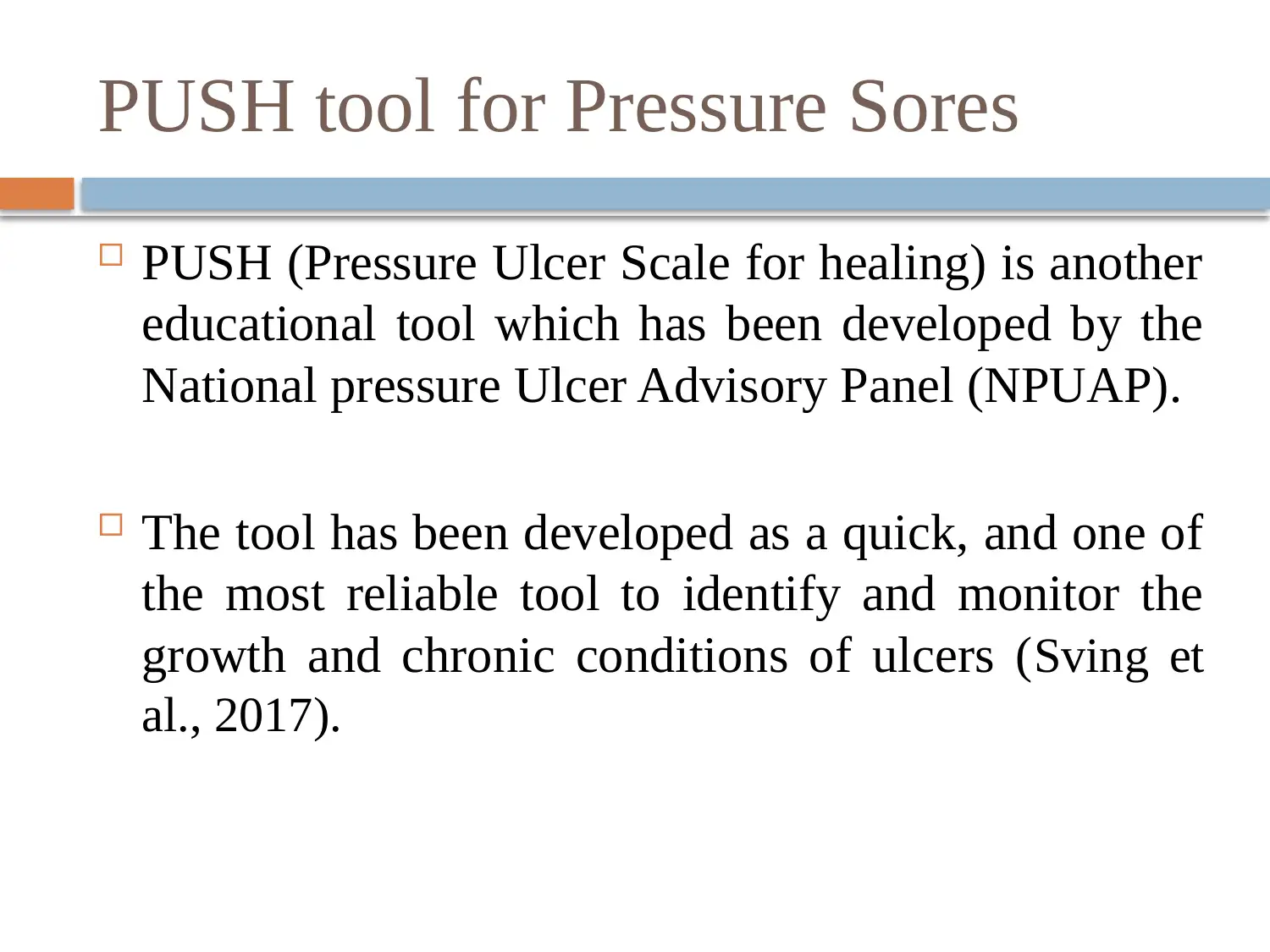
PUSH tool for Pressure Sores
PUSH (Pressure Ulcer Scale for healing) is another
educational tool which has been developed by the
National pressure Ulcer Advisory Panel (NPUAP).
The tool has been developed as a quick, and one of
the most reliable tool to identify and monitor the
growth and chronic conditions of ulcers (Sving et
al., 2017).
PUSH (Pressure Ulcer Scale for healing) is another
educational tool which has been developed by the
National pressure Ulcer Advisory Panel (NPUAP).
The tool has been developed as a quick, and one of
the most reliable tool to identify and monitor the
growth and chronic conditions of ulcers (Sving et
al., 2017).

The education tool or criteria of PUSH not only helps
in identifying the harmful impact of the pressure
injuries on the skin or tissues of the individual. In
addition, it also monitors the change in the status or
improvement of the person with the ulcers over time.
The PUSH tool measures three parameters which
indicates about the progress of healing. These
parameters include wound size, exudate amount, and
the type of tissue affected in the body (Zeigler et al.,
2016).
in identifying the harmful impact of the pressure
injuries on the skin or tissues of the individual. In
addition, it also monitors the change in the status or
improvement of the person with the ulcers over time.
The PUSH tool measures three parameters which
indicates about the progress of healing. These
parameters include wound size, exudate amount, and
the type of tissue affected in the body (Zeigler et al.,
2016).
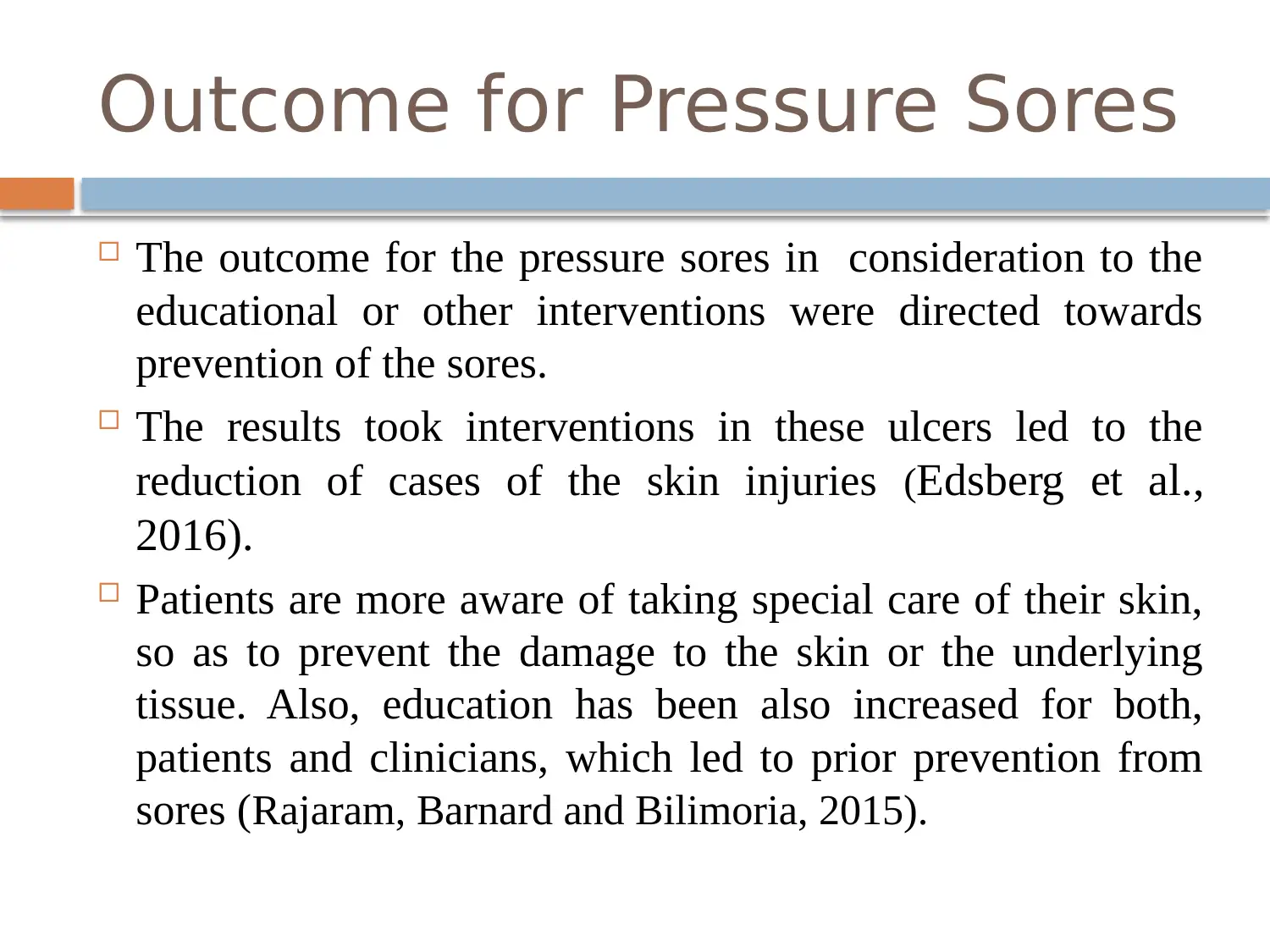
Outcome for Pressure Sores
The outcome for the pressure sores in consideration to the
educational or other interventions were directed towards
prevention of the sores.
The results took interventions in these ulcers led to the
reduction of cases of the skin injuries (Edsberg et al.,
2016).
Patients are more aware of taking special care of their skin,
so as to prevent the damage to the skin or the underlying
tissue. Also, education has been also increased for both,
patients and clinicians, which led to prior prevention from
sores (Rajaram, Barnard and Bilimoria, 2015).
The outcome for the pressure sores in consideration to the
educational or other interventions were directed towards
prevention of the sores.
The results took interventions in these ulcers led to the
reduction of cases of the skin injuries (Edsberg et al.,
2016).
Patients are more aware of taking special care of their skin,
so as to prevent the damage to the skin or the underlying
tissue. Also, education has been also increased for both,
patients and clinicians, which led to prior prevention from
sores (Rajaram, Barnard and Bilimoria, 2015).
Paraphrase This Document
Need a fresh take? Get an instant paraphrase of this document with our AI Paraphraser
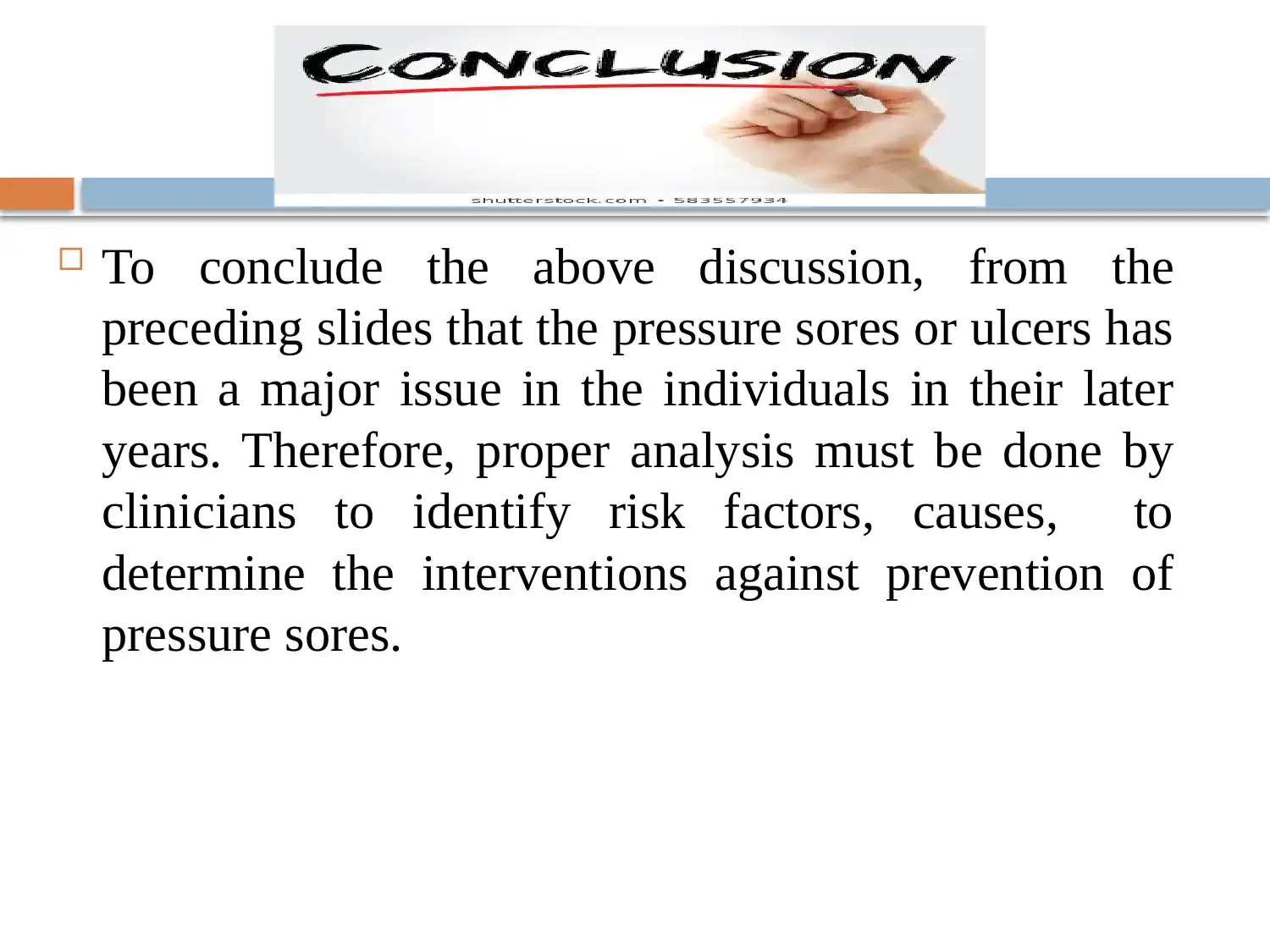
To conclude the above discussion, from the
preceding slides that the pressure sores or ulcers has
been a major issue in the individuals in their later
years. Therefore, proper analysis must be done by
clinicians to identify risk factors, causes, to
determine the interventions against prevention of
pressure sores.
preceding slides that the pressure sores or ulcers has
been a major issue in the individuals in their later
years. Therefore, proper analysis must be done by
clinicians to identify risk factors, causes, to
determine the interventions against prevention of
pressure sores.
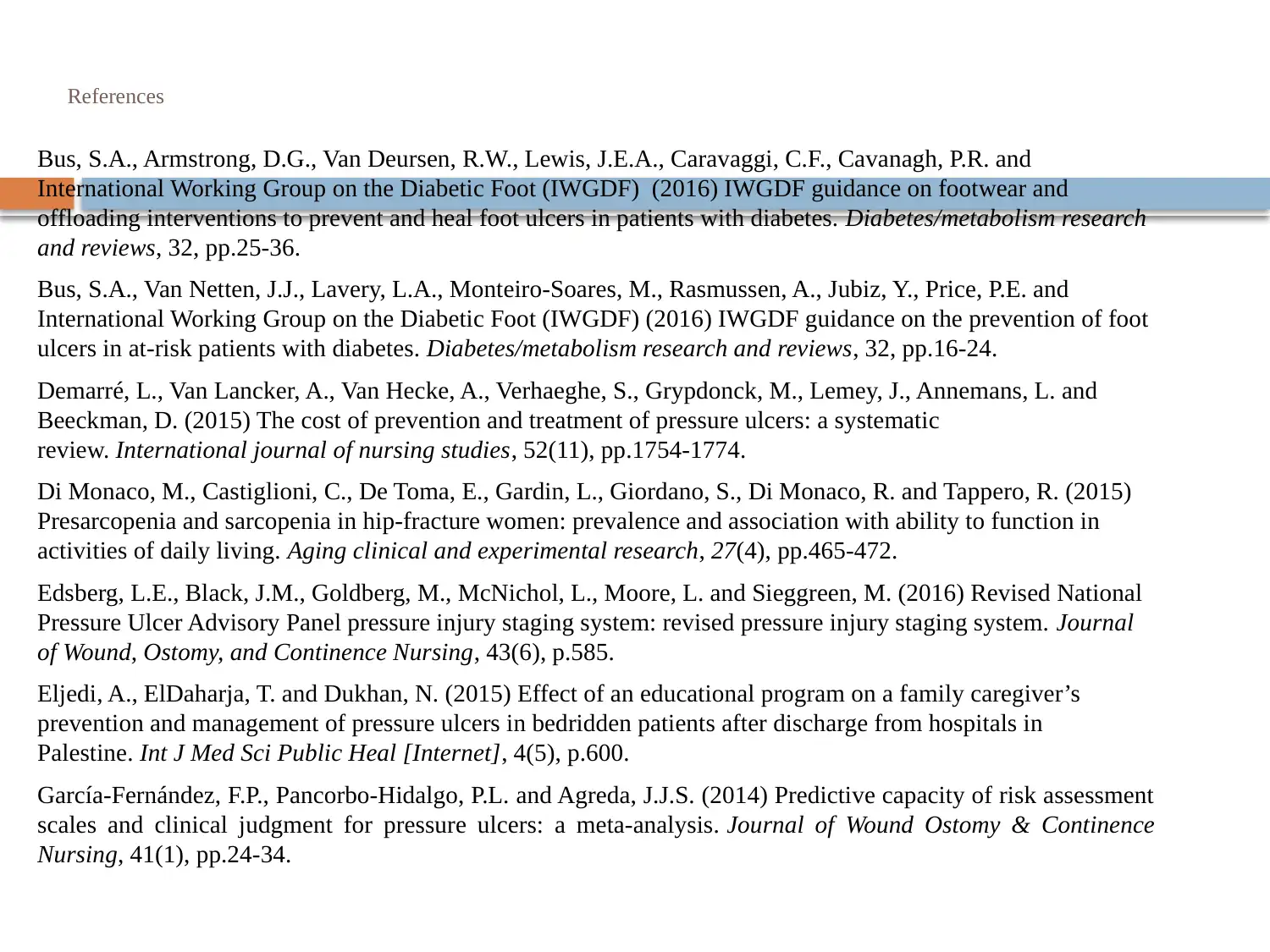
References
Bus, S.A., Armstrong, D.G., Van Deursen, R.W., Lewis, J.E.A., Caravaggi, C.F., Cavanagh, P.R. and
International Working Group on the Diabetic Foot (IWGDF) (2016) IWGDF guidance on footwear and
offloading interventions to prevent and heal foot ulcers in patients with diabetes. Diabetes/metabolism research
and reviews, 32, pp.25-36.
Bus, S.A., Van Netten, J.J., Lavery, L.A., Monteiro‐Soares, M., Rasmussen, A., Jubiz, Y., Price, P.E. and
International Working Group on the Diabetic Foot (IWGDF) (2016) IWGDF guidance on the prevention of foot
ulcers in at‐risk patients with diabetes. Diabetes/metabolism research and reviews, 32, pp.16-24.
Demarré, L., Van Lancker, A., Van Hecke, A., Verhaeghe, S., Grypdonck, M., Lemey, J., Annemans, L. and
Beeckman, D. (2015) The cost of prevention and treatment of pressure ulcers: a systematic
review. International journal of nursing studies, 52(11), pp.1754-1774.
Di Monaco, M., Castiglioni, C., De Toma, E., Gardin, L., Giordano, S., Di Monaco, R. and Tappero, R. (2015)
Presarcopenia and sarcopenia in hip-fracture women: prevalence and association with ability to function in
activities of daily living. Aging clinical and experimental research, 27(4), pp.465-472.
Edsberg, L.E., Black, J.M., Goldberg, M., McNichol, L., Moore, L. and Sieggreen, M. (2016) Revised National
Pressure Ulcer Advisory Panel pressure injury staging system: revised pressure injury staging system. Journal
of Wound, Ostomy, and Continence Nursing, 43(6), p.585.
Eljedi, A., ElDaharja, T. and Dukhan, N. (2015) Effect of an educational program on a family caregiver’s
prevention and management of pressure ulcers in bedridden patients after discharge from hospitals in
Palestine. Int J Med Sci Public Heal [Internet], 4(5), p.600.
García-Fernández, F.P., Pancorbo-Hidalgo, P.L. and Agreda, J.J.S. (2014) Predictive capacity of risk assessment
scales and clinical judgment for pressure ulcers: a meta-analysis. Journal of Wound Ostomy & Continence
Nursing, 41(1), pp.24-34.
Bus, S.A., Armstrong, D.G., Van Deursen, R.W., Lewis, J.E.A., Caravaggi, C.F., Cavanagh, P.R. and
International Working Group on the Diabetic Foot (IWGDF) (2016) IWGDF guidance on footwear and
offloading interventions to prevent and heal foot ulcers in patients with diabetes. Diabetes/metabolism research
and reviews, 32, pp.25-36.
Bus, S.A., Van Netten, J.J., Lavery, L.A., Monteiro‐Soares, M., Rasmussen, A., Jubiz, Y., Price, P.E. and
International Working Group on the Diabetic Foot (IWGDF) (2016) IWGDF guidance on the prevention of foot
ulcers in at‐risk patients with diabetes. Diabetes/metabolism research and reviews, 32, pp.16-24.
Demarré, L., Van Lancker, A., Van Hecke, A., Verhaeghe, S., Grypdonck, M., Lemey, J., Annemans, L. and
Beeckman, D. (2015) The cost of prevention and treatment of pressure ulcers: a systematic
review. International journal of nursing studies, 52(11), pp.1754-1774.
Di Monaco, M., Castiglioni, C., De Toma, E., Gardin, L., Giordano, S., Di Monaco, R. and Tappero, R. (2015)
Presarcopenia and sarcopenia in hip-fracture women: prevalence and association with ability to function in
activities of daily living. Aging clinical and experimental research, 27(4), pp.465-472.
Edsberg, L.E., Black, J.M., Goldberg, M., McNichol, L., Moore, L. and Sieggreen, M. (2016) Revised National
Pressure Ulcer Advisory Panel pressure injury staging system: revised pressure injury staging system. Journal
of Wound, Ostomy, and Continence Nursing, 43(6), p.585.
Eljedi, A., ElDaharja, T. and Dukhan, N. (2015) Effect of an educational program on a family caregiver’s
prevention and management of pressure ulcers in bedridden patients after discharge from hospitals in
Palestine. Int J Med Sci Public Heal [Internet], 4(5), p.600.
García-Fernández, F.P., Pancorbo-Hidalgo, P.L. and Agreda, J.J.S. (2014) Predictive capacity of risk assessment
scales and clinical judgment for pressure ulcers: a meta-analysis. Journal of Wound Ostomy & Continence
Nursing, 41(1), pp.24-34.

Graves, N. and Zheng, H. (2014) The prevalence and incidence of chronic wounds: a literature review. Wound Practice &
Research: Journal of the Australian Wound Management Association, 22(1), p.4.
Ham, W., Schoonhoven, L., Schuurmans, M.J. and Leenen, L.P. (2014) Pressure ulcers from spinal immobilization in trauma
patients: a systematic review. Journal of Trauma and Acute Care Surgery, 76(4), pp.1131-1141.
Källman, U. and Lindgren, M. (2014) Predictive validity of 4 risk assessment scales for prediction of pressure ulcer development
in a hospital setting. Advances in skin & wound care, 27(2), pp.70-76.
Lala, D., Dumont, F.S., Leblond, J., Houghton, P.E. and Noreau, L. (2014) Impact of pressure ulcers on individuals living with a
spinal cord injury. Archives of physical medicine and rehabilitation, 95(12), pp.2312-2319.
Partridge, J.S.L., Harari, D., Martin, F.C. and Dhesi, J.K. (2014) The impact of pre‐operative comprehensive geriatric assessment
on postoperative outcomes in older patients undergoing scheduled surgery: a systematic review. Anaesthesia, 69, pp.8-16.
Qaseem, A., Humphrey, L.L., Forciea, M.A., Starkey, M. and Denberg, T.D. (2015) Treatment of pressure ulcers: a clinical
practice guideline from the American College of Physicians. Annals of internal medicine, 162(5), pp.370-379.
Rajaram, R., Barnard, C. and Bilimoria, K.Y. (2015) Concerns about using the patient safety indicator-90 composite in pay-for-
performance programs. Jama, 313(9), pp. 897-898.
Ricci, J.A., Bayer, L.R. and Orgill, D.P. (2017) Evidence-based medicine: the evaluation and treatment of pressure injuries. Plastic
and reconstructive surgery, 139(1), pp. 275-286.
Stephens, M. and Bartley, C.A. (2018) Understanding the association between pressure ulcers and sitting in adults what does it
mean for me and my carers? Seating guidelines for people, carers and health & social care professionals. Journal of tissue
viability, 27(1), pp.59-73.
Sving, E., Fredriksson, L., Gunningberg, L. and Mamhidir, A.G. (2017) Getting evidence‐based pressure ulcer prevention into
practice: a process evaluation of a multifaceted intervention in a hospital setting. Journal of clinical nursing, 26(19-20), pp.3200-
3211.
VanGilder, C., Lachenbruch, C., Algrim-Boyle, C. and Meyer, S. (2017) The International Pressure Ulcer Prevalence™ Survey:
2006-2015. Journal of Wound, Ostomy and Continence Nursing, 44(1), pp.20-28.
Zeigler, M., Smiley, J., Ehrlich‐Jones, L. and Moore, J.L. (2016) Use of the Pressure Ulcer Scale for Healing (PUSH) in Inpatient
Rehabilitation: A Case Example. Rehabilitation Nursing, 41(4), pp. 207-210.
Research: Journal of the Australian Wound Management Association, 22(1), p.4.
Ham, W., Schoonhoven, L., Schuurmans, M.J. and Leenen, L.P. (2014) Pressure ulcers from spinal immobilization in trauma
patients: a systematic review. Journal of Trauma and Acute Care Surgery, 76(4), pp.1131-1141.
Källman, U. and Lindgren, M. (2014) Predictive validity of 4 risk assessment scales for prediction of pressure ulcer development
in a hospital setting. Advances in skin & wound care, 27(2), pp.70-76.
Lala, D., Dumont, F.S., Leblond, J., Houghton, P.E. and Noreau, L. (2014) Impact of pressure ulcers on individuals living with a
spinal cord injury. Archives of physical medicine and rehabilitation, 95(12), pp.2312-2319.
Partridge, J.S.L., Harari, D., Martin, F.C. and Dhesi, J.K. (2014) The impact of pre‐operative comprehensive geriatric assessment
on postoperative outcomes in older patients undergoing scheduled surgery: a systematic review. Anaesthesia, 69, pp.8-16.
Qaseem, A., Humphrey, L.L., Forciea, M.A., Starkey, M. and Denberg, T.D. (2015) Treatment of pressure ulcers: a clinical
practice guideline from the American College of Physicians. Annals of internal medicine, 162(5), pp.370-379.
Rajaram, R., Barnard, C. and Bilimoria, K.Y. (2015) Concerns about using the patient safety indicator-90 composite in pay-for-
performance programs. Jama, 313(9), pp. 897-898.
Ricci, J.A., Bayer, L.R. and Orgill, D.P. (2017) Evidence-based medicine: the evaluation and treatment of pressure injuries. Plastic
and reconstructive surgery, 139(1), pp. 275-286.
Stephens, M. and Bartley, C.A. (2018) Understanding the association between pressure ulcers and sitting in adults what does it
mean for me and my carers? Seating guidelines for people, carers and health & social care professionals. Journal of tissue
viability, 27(1), pp.59-73.
Sving, E., Fredriksson, L., Gunningberg, L. and Mamhidir, A.G. (2017) Getting evidence‐based pressure ulcer prevention into
practice: a process evaluation of a multifaceted intervention in a hospital setting. Journal of clinical nursing, 26(19-20), pp.3200-
3211.
VanGilder, C., Lachenbruch, C., Algrim-Boyle, C. and Meyer, S. (2017) The International Pressure Ulcer Prevalence™ Survey:
2006-2015. Journal of Wound, Ostomy and Continence Nursing, 44(1), pp.20-28.
Zeigler, M., Smiley, J., Ehrlich‐Jones, L. and Moore, J.L. (2016) Use of the Pressure Ulcer Scale for Healing (PUSH) in Inpatient
Rehabilitation: A Case Example. Rehabilitation Nursing, 41(4), pp. 207-210.
1 out of 22
Related Documents
Your All-in-One AI-Powered Toolkit for Academic Success.
+13062052269
info@desklib.com
Available 24*7 on WhatsApp / Email
![[object Object]](/_next/static/media/star-bottom.7253800d.svg)
Unlock your academic potential
© 2024 | Zucol Services PVT LTD | All rights reserved.




